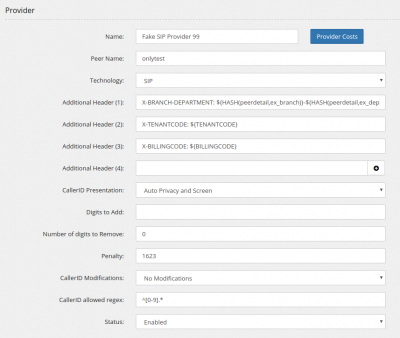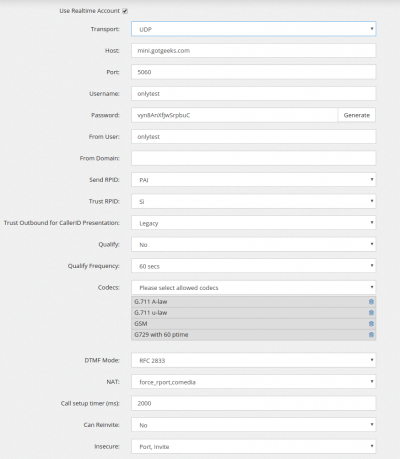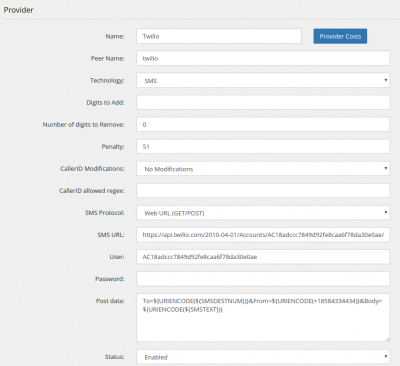Providers
Admin Providers allows creating the needed data for any inbound and outbound provider used by the system.
Name - The name of the provider is just a label to refer to this provider in the system. Peer Name - This is how Asterisk will refer to the account associated with the Provider. It is really important to use just a single label. Never use an IP address or a FQDN, otherwise, you can experience some problems with provider selection. Technology - You can use different protocols for the provider. The most common and used one is SIP, but you can also use DAHDI, IAX2, LOCAL and SMS provider. For SMS providers you'll need to choose the protocol used. Additional Header - You can create several SIP headers to send together with the call. You can even use the Asterisk variables like ${TENANTCODE} or ${BILLINGCODE}, just to name the most common ones. CallerID Presentation - What kind of CallerID Presentation to show to the Provider Digits to Add - If you want to add a prefix before dialing with this provider. Usually, this is a "security" prefix some providers are requiring. This prefix will not show in the Call History Number of digits to Remove - How many digits to remove from the start of the dialed number Penalty - The Penalty is roughly the weighted number of calls processed by the system. Every time a call is processed by this provider, the Penalty is increased by the weight assigned to the rule. This value is only used for balancing calls over multiple providers. CallerID Modification - allows adjusting the CallerID for outbound calls. If you want to adjust the CallerID for inbound calls, you need to refer to the DID section CallerID allowed regex - permits to verify if the CallerID being used in the call is allowed or not. If not, the default CallerID for the tenant will be used
SIP Providers
When using a Realtime Account, you can enter all the SIP peer details. When not using a Realtime Account, you need to enter the same info in sip.conf and reload SIP module every time there is a change. Not using a Realtime Account is discouraged
When defining the Host, you can use the FQDN for outbound providers, you NEED to use the IP Address for inbound providers.
Don't forget to list the allowed Codecs
SMS Providers
An SMS provider permits to send SMS to mobile phones. You can choose between three protocol types:
- Web URL (GET/POST) - This is the most common and simple one. The SMS is sent over an HTTP connection. You can define the URL, the user, password and the optional post data. For example, for Twilio, you'll use something like:
SMS URL: https://api.twilio.com/2010-04-01/Accounts/AC18adccc7849d92fe8caa6f78da30e0ae/Messages.json
It is important to wrap elements in URIENCODE function
- WEB URL (JSON) - Newer providers are more comfortable with JSON data. Like the previous one, you can enter all the information. For example, for Bandwidth, you'll use something like:


